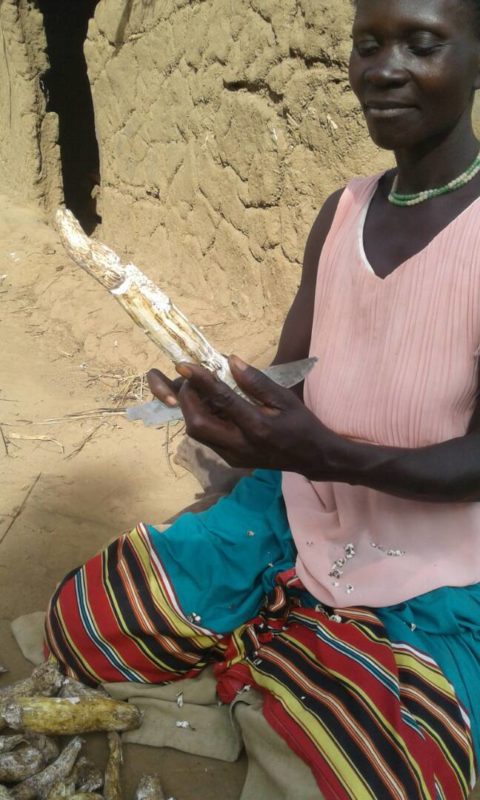Slivia Okello, a smallholder farmer in Uganda, grows cassava organically — though it contains potentially fatal levels of poisonous cyanic compounds — to ensure her family’s food security.
Okello, who lives in the village of Kiryatungula in Uganda’s Kiryandongo district, has cultivated this poisonous variety of cassava for over 20 years and believes that its benefits as hardy, disease-resistant crop outweigh its risks.
“This cassava, Karangwa, is part of our community,” Okello said. “We grow it for our consumption and for making alcohol. This bitter variety is not as prone to the diseases that attack the sweet varieties. Even animals like goats that normally destroy other varieties stay clear of Karangwa.”
Finding food in poisonous cassava
Like the old proverb “one man’s meat is another man’s poison,” Okello and her family turn to this potentially lethal cassava variety for food. She says a careful preparation process makes its consumption possible.
But if eaten without proper processing, the cyanic compounds in Karangwa can cause death, especially among infants. Several incidences of poisoning from toxic cassava have been reported across Uganda in recent years. In January 2017, a five-year old child died and four others were hospitalized after they consumed a cassava meal they prepared without the assistance of their mother. In September 2016, 24 people were admitted to the hospital after consuming meals from cassava flour they bought from a truck vendor. In March 2017, a 10-year-old boy died and four others were hospitalized after consuming “immature”cassava. Medical reports showed the boy died from dehydration caused by excessive vomiting. In September 2017, two young children died and 44 others were hospitalized after eating cassava prepared at a vigil.
All of these fatalities were from indigenous natural cassava varieties that were cultivated organically.
“When we harvest this cassava, we peel it and set it out in the sun for around three hours, after which we take it inside and cover it up for three days to ferment,” Okello explained. “After fermenting, the outermost part that makes it bitter is scrapped off with a knife, and the remaining part is sliced and dried. Later on, it is pounded and used for making bread.”
Her community has eaten this type of bread for years. No government agency or food activists have ever assessed its safety.
“Children in this community know this cassava should not be eaten when it is raw,” she said simply.

According to the United Nations Food and Agriculture Organization (FAO), traditional cassava processing and cooking methods like the ones used by Okello, if executed well, can reduce the cyanide content to non-toxic levels. The FAO also confirms that the community’s traditional practice of peeling and scraping the crop essentially eliminates the parts with the highest concentrations of cyanic compounds.
Sarah Kirya, another cassava farmer in this community, does not grow the poisonous Karangwa. It is not its potential dangers that scare her off, however.
“The bitterness is not the reason I don’t grow Karangwa. It is because I do not want to promote the production of local gin in my community, as I feel I would be encouraging the alcohol consumption that has wasted lives of youths in this community,” Kirya said.
Beside its use as a food source, Karangwa is a highly-preferred cassava variety for making waragi, an alcoholic distillate made from a fermented mixture of cassava and sorghum.
While the two farmers arrived at different decisions on whether to grow Karangwa, Okello’s choice is based on her need for food while Kirya’s avoidance is due to concerns about the potential harm that its use in creating alcohol would have on her community. But there is no conflict between these two farmers because no third party has come in to claim a higher moral ground in a system that has co-existed amicably for decades.
The current food safety talk
Despite the fatal incidences associated with these toxic varieties, there is no regulation in place to warn unsuspecting consumers about the dangers of eating cassava products that have not been well processed. Nor has the government adopted any rules mandating how it should be handled, even in food sales to the public.
This is likely to continue given current trends that position everything that is considered “natural” or “organic” as safe for human consumption. Discussions of food safety in Uganda only gained prominence when farmers here started conducting field trials for genetically engineered (GE) crops and the government introduced Uganda’s Biosafety Bill to fulfill its international commitment to the Cartagena Protocol, which requires parties to regulate living modified organisms.
Those opposed to the introduction of GE crops in Uganda twisted the intention of regulation by disingenuously suggesting that the need for regulations must mean that GE crops are unsafe.
These manufactured safety concerns persist despite scientists and scientific bodies around the world concluding that the GMOs on the market are safe for food and feed. Meanwhile, the acreage devoted to growing GE crops is ever-increasing around the world. As reported by the International Service for the Acquisition of Agri-biotech Applications (ISAAA) in its 2017 report, biotech crops are now grown on 190 million hectares globally.
But despite the evidence, some anti-GMO activists continue to espouse the “precautionary” position that implies that farmers should ignore current safety facts and instead wait — just in case GE crops are eventually proven unsafe.
The irony here is that communities like the one Okello and Kirya come from have repeatedly chosen to grow indigenous crops that pose risks that are both certain and fatal. These communities continue to grow bitter cassava despite known incidences of harm and even death. Meanwhile, activists sow seeds of fear to keep them growing crops proven safe through rigorous scientific tests and trials.
